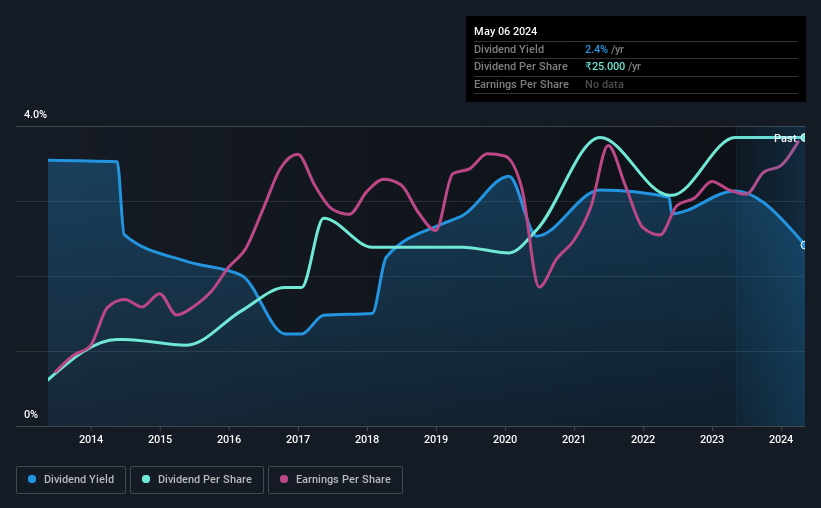- India
- /
- Auto Components
- /
- NSEI:RBL
Rane Brake Lining's (NSE:RBL) Shareholders Will Receive A Bigger Dividend Than Last Year
Rane Brake Lining Limited (NSE:RBL) has announced that it will be increasing its periodic dividend on the 31st of July to ₹30.00, which will be 20% higher than last year's comparable payment amount of ₹25.00. This will take the annual payment to 2.4% of the stock price, which is above what most companies in the industry pay.
See our latest analysis for Rane Brake Lining
Rane Brake Lining's Dividend Is Well Covered By Earnings
A big dividend yield for a few years doesn't mean much if it can't be sustained. Based on the last payment, Rane Brake Lining's earnings were much higher than the dividend, but it wasn't converting those earnings into cash flow. In general, we consider cash flow to be more important than earnings, so we would be cautious about relying on the sustainability of this dividend.
Looking forward, earnings per share could rise by 2.4% over the next year if the trend from the last few years continues. Assuming the dividend continues along recent trends, we think the payout ratio could be 67% by next year, which is in a pretty sustainable range.

Dividend Volatility
While the company has been paying a dividend for a long time, it has cut the dividend at least once in the last 10 years. The annual payment during the last 10 years was ₹4.00 in 2014, and the most recent fiscal year payment was ₹25.00. This means that it has been growing its distributions at 20% per annum over that time. Rane Brake Lining has grown distributions at a rapid rate despite cutting the dividend at least once in the past. Companies that cut once often cut again, so we would be cautious about buying this stock solely for the dividend income.
Dividend Growth May Be Hard To Achieve
Given that the dividend has been cut in the past, we need to check if earnings are growing and if that might lead to stronger dividends in the future. Earnings has been rising at 2.4% per annum over the last five years, which admittedly is a bit slow. Growth of 2.4% per annum is not particularly high, which might explain why the company is paying out a higher proportion of earnings. While this isn't necessarily a negative, it definitely signals that dividend growth could be constrained in the future unless earnings start to pick up again.
Our Thoughts On Rane Brake Lining's Dividend
Overall, this is probably not a great income stock, even though the dividend is being raised at the moment. While the low payout ratio is a redeeming feature, this is offset by the minimal cash to cover the payments. We would probably look elsewhere for an income investment.
Market movements attest to how highly valued a consistent dividend policy is compared to one which is more unpredictable. At the same time, there are other factors our readers should be conscious of before pouring capital into a stock. As an example, we've identified 2 warning signs for Rane Brake Lining that you should be aware of before investing. If you are a dividend investor, you might also want to look at our curated list of high yield dividend stocks.
New: AI Stock Screener & Alerts
Our new AI Stock Screener scans the market every day to uncover opportunities.
• Dividend Powerhouses (3%+ Yield)
• Undervalued Small Caps with Insider Buying
• High growth Tech and AI Companies
Or build your own from over 50 metrics.
Have feedback on this article? Concerned about the content? Get in touch with us directly. Alternatively, email editorial-team (at) simplywallst.com.
This article by Simply Wall St is general in nature. We provide commentary based on historical data and analyst forecasts only using an unbiased methodology and our articles are not intended to be financial advice. It does not constitute a recommendation to buy or sell any stock, and does not take account of your objectives, or your financial situation. We aim to bring you long-term focused analysis driven by fundamental data. Note that our analysis may not factor in the latest price-sensitive company announcements or qualitative material. Simply Wall St has no position in any stocks mentioned.
About NSEI:RBL
Rane Brake Lining
Manufactures and markets auto components to original equipment manufacturers and aftermarket customers in India and internationally.
Solid track record with excellent balance sheet and pays a dividend.
Similar Companies
Market Insights
Community Narratives



